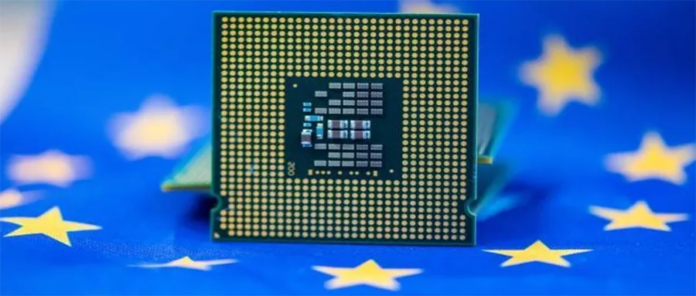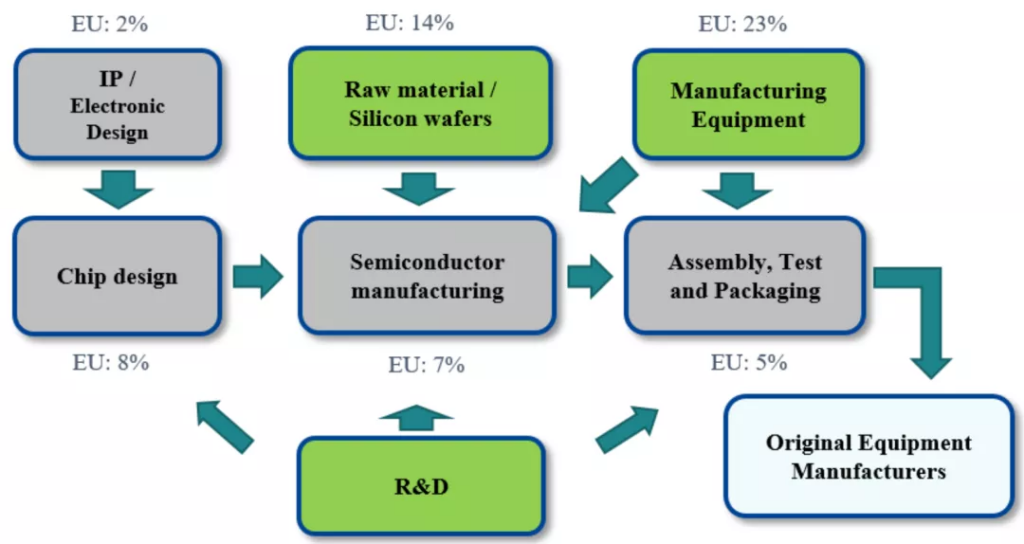
February 8, the European Commission’s long-awaited “ AChips Act for Europe” was finally officially introduced. The actl, which is 22 pages long since last year’s preparations, plans to invest more than 43 billion euros to boost the European chip industry and reduce Europe’s dependence on U.S. and Asian companies.

European Commission President Ursula von der Leyen said in a statement that the European chip act will connect research, design, and testing, and coordinate EU and national investments.
Three main components
The act includes three main components – the Chips for European Initiative, a new framework to ensure security of supply, and an EU-level coordination mechanism:

The Chips for European Initiative will be strengthened through the strategic repositioning of existing joint commitments on key digital technologies, pooling resources from the EU, member states, and third countries related to existing EU programs and the private sector. The €11 billion will be used to strengthen existing research, development, and innovation to ensure the deployment of advanced semiconductor tools, as well as prototyping, testing and pilot production lines for new devices for innovative real-life applications, and to build advanced technical and engineering capabilities in quantum chips.
A new framework to ensure security of supply by attracting investment and increasing production capacity, which is urgently needed for the boom in advanced node innovation and energy-efficient chips. In addition, the Chips Fund will provide financing channels for startups to help them mature innovations and attract investors. It will also establish a dedicated semiconductor equity fund under InvestEU to support scale-up and SMEs to ease their market expansion. To attract investment, the proposed regulation defines two types of facilities that are considered to contribute to European security of supply. These are so-called Open EU foundries, which design and produce components mainly for other industrial enterprises, and so-called Integrated Production Facilities, which design and produce components to serve domestic markets.

A coordination mechanism between member states and the Commission. It will monitor the semiconductor value chain by gathering key intelligence from companies to identify major weaknesses and bottlenecks. It will bring together common crisis assessments and coordinate actions to be taken from a new emergency toolkit. It will also make full use of national and EU instruments for a joint rapid and decisive response.
In addition, the European Commission proposes a joint crisis assessment and coordinated response, which enables a coordination mechanism between the Member States and the Commission to start immediately.
Why is the EU urgently legislating the development of the chip industry?
Europe currently has clear advantages and disadvantages in the global semiconductor ecosystem.

On the one hand, it has many excellent universities and research institutions, leads the production technology of some world’s most advanced chips, and has a favorable position in the field of some upstream materials and equipment for chip manufacturing. On the other hand, in 2020 the world made a total of 1 trillion microchips, while Europe’s share of which is less than 10%, and heavily dependent on third-country suppliers. If the global supply chain is severely disrupted, the chip reserves of some European industrial sectors could be depleted in a few weeks, leading many European industries to a standstill. This has exposed the fragility of the chip ecosystem in Europe.
To strengthen Europe’s leadership in the semiconductor sector, the act aims to achieve five objectives:
- Strengthen Europe’s research and technology leadership in smaller, faster chips.
- Develop a framework to increase production capacity to 20% of the global market by 2030, which means doubling the current market share of EU countries.
- Building and strengthening innovation capabilities in advanced chip design, manufacturing and packaging.
- Developing an in-depth understanding of the global semiconductor supply chain.
- Addressing skills shortages, attracting new talent, and supporting the emergence of a skilled workforce.
Europe has been planning for a long time
The European Commission believes the European Chip Act is a milestone for Europe that will benefit its industry, economy and society, provide highly skilled jobs and new markets for European businesses, help Europe gain geopolitical independence, become a major player in the global semiconductor ecosystem, and provide a diverse and resilient supply chain for the world.

Indeed, as early as last year’s State of the Union address, European Commission President Ursula von der Leyen had already set out a vision for a European chip strategy that would create a most advanced European chip ecosystem, including production, connecting the EU’s world-class research, design, and test capabilities.
In July 2021, the European Commission launched the European Alliance on Processors and Semiconductor technologies to identify the current gaps in microchip production and the technological developments needed for the growth of companies and organizations.
The Alliance will help facilitate cooperation between existing and future EU initiatives and play an important advisory role and provide a strategic roadmap for the European Initiative Chip as well as other stakeholders.
In a joint declaration signed in December 2020, the 22 member states have so far committed to working together to support Europe’s electronics and embedded systems value chain and to strengthen leading-edge manufacturing capabilities.

These new measures will help Europe achieve the goal of the “Digital Decade 2030”, which is to capture 20% of the global chip market by 2030, with production capacity sprinting to 2nm and 10 times the energy efficiency of today.
Chips – a core strategic asset for digital transformation
From a global perspective, this legislative initiative of the EU is the same as the actions of U.S. President Joe Biden after his inauguration, who is also pushing for the enactment of the $52 billion USA Chip Act to consolidate and strengthen the strength of U.S. domestic chip production.
As can be seen, as a key strategic asset, chip supply is extremely dependent on a very limited number of players, and achieving an autonomous and controlled indigenous semiconductor industry chain is increasingly valued by countries around the world. This core industry, which is at the center of geopolitical interests, is holding the ability of countries to promote digital transformation.
(Source: Europa, Twitter)



